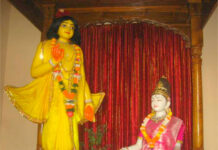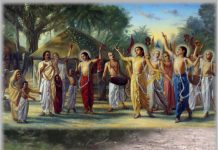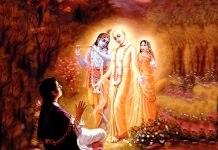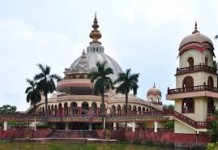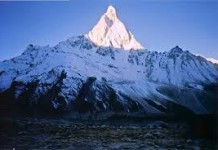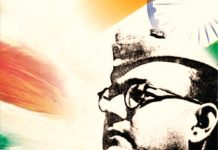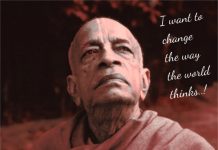The Natya Shastra of Bharatmuni describes the divine origin of classical dance. As Lord Brahma created the fifth Veda by incorporating the “Pathyam” or recitation from Rig Veda, “Geetam” or melody from Sama Veda, Abhinaya from Yajur Veda and Rasa from Atharva Veda, and presented it to Bharat Muni, a dance drama was enacted in front of Lord Shiva.
A deficiency of pure dance or “Nritta” was felt by Lord Shiva, and Tandu Muni was asked to teach Bharat Muni and his disciples the art of dance. Thus “Tandava” was born. Tandu Muni instructed Bharat muni in the use of Angaharas and the Karanas.
The 32 angaharas and 108 karanas are used in the classical arts of dance and music, and have an inherent stamp of the modes and rituals of the Shaivite tradition extensively.
Another account tells the divine origin of Odissi dance, wherein the Apsara Rambha came down to perform along with Gandharvas as musicians at the occasion of the ceremonial installation of Lord Jagannath in the temple at Puri. Rambha has been said to have taught the Devadasis of the Jagannath temple, and the pristinity and purity of the divine origin of dance has been said to have continued since then.
Another account states that as Lord Shiva traversed the cosmic universal spaces filled with great anger and grief with the body of Sati, he performed the “Rudra Tandava”.
The Shiva Pradosh Stotra states that all gods and goddesses play their respective instruments when Lord Shiva performs the “Sandhya Tandava” in the evenings at Kailash.
Various forms of Tandava have their variations as the Samhara Tandava, Kali Tandava, Uma Tandavam Ananda Tandava, Gauri Tandava and Tripur Tandava.
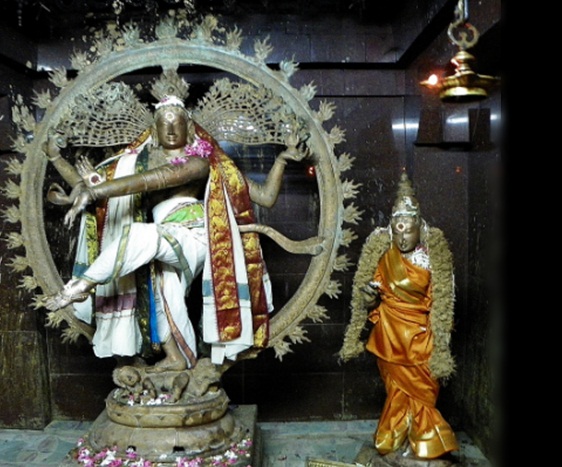
The temple dances, especially Bharatnatyam and Odissi retained their chaste form as mentioned in the Natya shastra, and were practiced in the temples of south India and Orissa respectively.
The institution of the “Devadasi” or the female attendants dedicated to the worship and service of a Diety in a temple has found mention even in the Puranas. Ancient religious texts state that Lord Shiva Himself said that a dancing girl given to his temple is a religious firmament of Hindu ideology, and that there should be dancing in his temples at all times.
“Meghdoot” written by Kalidasa refers to several dancing girls present in the famed Mahakaal Temple of Ujjain at his time.
It is dated back more than the known history of the present age. The Devadasis held a high social and religious status, and were attached to the temples contributing their services as accomplished singers, dancers and philosophers.
The grandeur of the original Somnath Temple in Gujarat was affirmed by the presence of a large number of singing and dancing girls permanently attached to this temple along with the fact that a major portion of the temple wealth was incorporated in the original Somnath Shivling that lay suspended in the air.
There were around 400 Devdasis attached to the temples of Travancore and Tanjore.
In Tamil Nadu, they were called as “ Deva Adigalar”. The Brihadeshwara Temple of Thanjavur maintained 400 Devadasis, accompanied by the Nattuvanars or the dance gurus and the orchestra. A separate form of dance and music was devised for the temple services.
The dance forms were supposed to be so pure and pristine that the sculptures ornamenting these exquisite temples showed their postures, some of whom are quite rare and unique. Equally well are the stated “Agamas” or the rules for temple worship wherein dance and music are supposed to be inherent constituent of Deity worship.
The Jagannath temple was behest with high status Devadasis, which were also called as “Maharis” in Orissa. The Devadasis were divided into groups according to their services, as the ‘Nachuni’ or the female dancer, the ‘Bhitara Gauni’ and the ‘Bahar Gauni’ being the singers for the inner and the outer chambers repectively. The ‘Sebayats’ were the male servants of the Lord whose main functions was to assist the Devadasis to and back from the temple and see to that they lead chaste and honorable lives.
The services of the Devadasis officially began with a formal wedding ceremony with the Lord between the ages of 8 to 16, whereby they began to called by the name “Jogini”.
Such was the divinity of temple dance and status of the Devadasis was as revered as a core constituent of Deity worship itself. The Maharis offered their dances as pure Nritta, in the “Sakala Dhupa” in the Nata Mandir. The next dance was at time of the “Bada Shringar” or the bedtime of the Lord, where the dance was in the form of Nritya, being expressive, with Rasa and Bhava. The Raj Guru was always supposed to be present in the dance, and so revered was supposed to be the status of the Devadasis and the divinity of their dance, that the King, or anyone else was only supposed to look at their feet, with the exception of the musicians who were considered as a status par with them, above human beings.
The Muslim invasion brought about a major degradation to not only the temples, but a massive blow to the temple dancing, music, and Devadasi culture. The great rampage was seen in the Somnath temple, and as North India witnessed a fast wiping out of the ancient Hindu temple culture, south India witnessed a slower pace. The British discouraged the entire system of the Hindu temple culture, and looked at it with contempt. They removed all financial and social benefit platforms for the temple artists, and Indian art forms of dance and music. However, there was a massive serious effort post independence by some famous dance gurus to revive the original art form.
This effort has managed to revive the art of classical dance and give it a social standing. Indian classical dance and music have found a place across platforms and stages round the world, but unfortunately, the divinity, pristinity and the purity of the classical dance forms that take their roots for the devotional practice of using dance as a means of Deity worship has lost it’s way. The dances are being used by the student as a means of gaining wealth and popularity, making the arts as more export oriented. The original chaste base of Indian classical arts are synonym with the idea that the performer is inherently satisfied with a pristine form of sole Deity worship through his art. This is the main idea of the learning, evolution and propagation of arts in temples as a form of divine worship.
It is signified that temple arts go beyond the symbol of recognition, of competition between the artists, and the performers, for divinity and worship have no comparisons. Each artist venerates his Deity in his own unique form, a feature that take the temple arts of ancient India towards their intended divinity.
Hindu temple arts chart the course of their artist through the role of creation as a learner, evolution as a practitioner and dissolution towards divinity all through the course of his life, following the life course of his art through the chapters of divine origin, existence with the divine and annihilation


